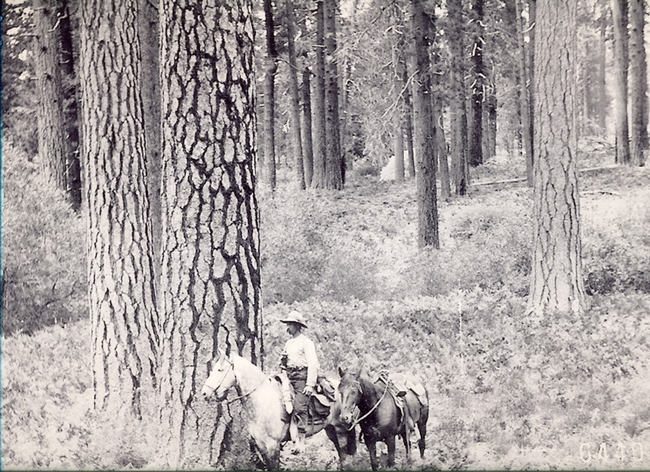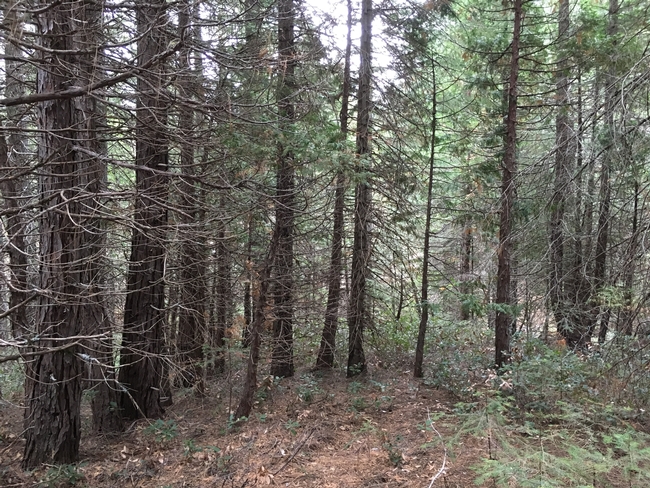You may have seen historic photos of Sierra Nevada forests with cars driving between the large trees, or heard how one could ride their horse from the woods into town with little difficulties. Those open forests with fewer trees were highly variable in structure and more resilient than forests of today. But what does that actually mean? Ryan Tompkins, Forestry and Natural Resources Advisor and Registered Professional Forester with the University of California Agriculture and Natural Resources, explains the connection between fewer trees and a resilient forest.
Photo: USDA Forest Service
What is forest resilience? Forest resilience is a measure of adaptability. It focuses on retaining a forest's essential structure and composition to a range of stresses or complex disturbances. In other words, a resilient forest may lose some trees to drought, fire or insect attack, but the mortality rate will not overtake the forest's ability to continue growing trees and provide habitat. Some will die, but many will live.
Today's forests have huge increases in basal area and tree density compared to the historical record. Historically, forests were generally low in density yet highly variable in their structure, with open patches and clumps of trees. Twenty-two trees per acre was not uncommon in the Sierras, but those 22 trees were huge! The older and bigger trees get, the more adaptations they have, like thicker bark, a high canopy and higher levels of resilience to disturbances. We have normalized high density, homogeneous stand structure and high competition forests that would not have occurred historically. Today's forests are more vulnerable to fire and drought related mortality due to a legacy of timber harvesting in early 1900's that focused on large tree removal; a century of fire suppression policy and action, and climate change effects such as less humidity recovery in the night.
Photo: Forest Stewardship Education Initiative Program
What about forest understory? The mosaic effects of fire in historic fire regimes was due to greater understory diversity characterized by grasses, forbs, limited shrubs, and more bare ground. Today's thick understory means a less diverse understory, more resource competition between shrubs and small trees, and greater fuel loads to carry fire throughout the forest. Once impacted by severe fire, it is more likely that shrubs will take over burned areas and overtake any seedlings that are planted or regenerated.
What should today's forest landowners do to increase forest resilience? Aiming for historical tree density may be hard depending on your overall management goals, and the California Forest Practice Rules may not even allow for it. Optimal forest density for your forest depends in part on the productivity of your site and your objectives, but many forest ecologists and managers are advocating for maintaining lower densities of trees. Think about forest structure in two regards: 1) how fire moves through forests during the peak of fire season, and 2) how trees might compete for water during a drought, when considering what management actions to take.
Activities to reduce forest density and increase forest resilience include:
Hand thinning, piling and burning
- This is a good first step for DIYers to remove ladder fuels and some surface fuels;
- Generally, no permits are required if you are on your own property and not using cost-share funding to support the work; and
- It's a nice way to introduce prescribed fire activities if you let the fire in the piles start to creep around, after you put a fire line around them!
- It's a great way to address surface and ladder fuels, but depending on your forest structure may not remove enough competing trees to make your forest resistant to drought
Mastication
- Changes vertical fuel (like small trees and shrubs) down to ground fuel but does not remove them. It simply adds them to surface fuels;
- When masticated fuels burn, they have lower flame lengths but can continue to burn/smolder for a longer time period which can increase fire effects to residual trees;
- It delivers quick results, and can operate most of the year; and
- Decomposition rates will vary between locations.
Mastication plus fire: A combination of treatments that can have unexpected results, both positive and negative. Though flame lengths are low, the fire has a long residence time, which can cook and kill residual trees. It's better to wait a few years after mastication for the material to decompose before burning it.
Timber harvesting or commercial thinning:
- Sometimes you have to commercially thin in order to restore lower density forest conditions;
- You can leverage saw logs/forest products to pay for other management activities; and
- It is effective in reducing tree density in the canopy and ladder fuels and reduces competition for the remaining trees.
Commercial thinning plus prescribed fire: Very effective in reducing tree density, ladder fuels and surface fuels. Combining meaningful thinning and prescribed fire can mitigate fire hazard and improved the growth and vigor of your trees to maximize resistance and resilience to wildfire and drought-related tree mortality!
For more information on what forest resilience is and how it is measured, read “Operational resilience in western US frequent-fire forests” by Malcolm P. North, Ryan E. Tompkins, Alexis A. Bernal, Brandon M. Collins, Scott L. Stephens, and Robert A. York. Click here to view a virtual panel discussion and presentation with the authors.
For more background on the history of California forests, visit Forest Stewardship Series 4 – Forest History. For more information on tree growth and competition, as well as vegetation management activities, visit Forest Stewardship Series 5 – Tree Competition and Growth. and Forest Stewardship Series 6 – Forest Vegetation Management.

